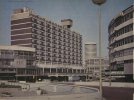But my mind keeps coming back to the question of why doesn't it seem to grasp the idea of coherence? And by that I mean: "a logical, orderly, and aesthetically consistent relationship of parts". Just doesn't seem to happen when it comes to planning.
I was born in London were I lived for 30 years, and I have now lived in Birmingham for 30 years.
It seems to me one of the problems with Birmingham is that rather than "tinkering at the edges" to improve the city the developers keep going for massive grand designs that involve knocking down and redeveloping large parts of the city, so the city is constantly changing.
In the 1960s and 1970s the ring road and other major roads were built, now they are trying to get rid of some them.
In he 1970s the whole area round the Bull Ring was redeveloped, then 10 years ago they knocked it all down and redeveloped it.
In the 60s and 70s they knocked down the old "New St station" to build a new one, and now they are knocking most of it down to build another one.
In the 1980s much land around Broad St was knocked down to create the NIA, ICC, Symphony Hall etc.
In the 1970s they built the existing library and redeveloped the area around it, soon they will knock it all down and build another huge project.
On the other side of the road the old Central TV buildings, and other buildings around it, are currently being knocked down for another huge development.
Corporation St is now closed to traffic while they build a tram system linking Snow Hill station with New St station.
All of these are massive projects, and many do improve the city, but they do change the character of areas totally, and are usually built in the "modern" style, but that "modern" style quickly goes out of fashion so they area soon looks dated.
In fact when walking round central Birmingham the place seems to be one huge building site.



